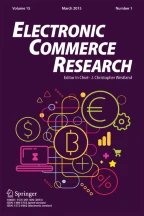Abstract
Lack of consumer trust in e-commerce merchants, e-commerce technology, and the social, financial and legal infrastructures of the e-commerce environment, poses a major challenge to the large-scale uptake of business to consumer e-commerce. Most traditional cues for assessing trust in the physical world are not available online. This paper gives an overview of some of the work being done to devise alternative methods for assessing, communicating and establishing trust in this environment. Examples are drawn from a wide range of disciplines including human–computer interaction, usability, marketing, information technology, mathematics, linguistics and law. Industry, self-regulatory and government initiatives aimed at building consumer trust and confidence in e-commerce are also discussed.
Similar content being viewed by others
References
Abdul-Rahman, A. and S. Hailes. (1997). “A Distributed Trust Model.” In Proceedings of the 1997 New Security Paradigms Workshop. ACM, pp. 48-60.
Andersen, R. (2001). Security Engineering. Wiley.
Axelrod, R. (1984). The Evolution of Cooperation. New York: Basic Books.
Benner, J. (2001). “MS Gets Privacy-Happy With New IE.” Wired News http://www.wired.com/ news/privacy/0,1848,43686,00.html.
Beskow, J. and S. McGlashan. (1997). “Olga: A Conversational Agent with Gestures.” In Proceedings of the IJCAI'97 Workshop on Animated Interface Agents: Making Them Intelligent Nagoya, Japan.
Bickmore, T. and J. Cassell. (2001). “Relational Agents: A Model and Implementation of Building User Trust.” In CHI 2001 Conference Proceedings. ACM Press.
Bond, M. (2000). “Role of Stakeholders in Identifying Essential Elements of Trustmark Programs, Codes of Conduct and Dispute Resolution Schemes.” In Proceedings of the Joint Conference of the OECD, HCOPIL, ICC: Building Trust in the Online Environment: Business to Consumer Dispute Resolution The Hague, http://www.oecd.org/dsti/sti/it/secur/act/online_trust/presentations.htm.
Carblanc, A. (2000). “Privacy Protection and Redress in the Online Environment: Fostering Effective Alternative Dispute Resolution.” In Proceedings of the 22nd International Conference on Privacy and Personal Data Protection.
Cavoukian, A. and M. Crompton. (2000). “Web Seals: A Review of Online Privacy Programs.” A Joint Project of The Office of the Information and Privacy Commissioner/Ontario and The Office of the Federal Privacy Commissioner of Australia, http://www.ipc.on.ca/english/pubpres/papers/seals.pdf.
Cheskin Research. (2000). Trust in the Wired Americas. Cheskin Research, http://www.cheskin.com/think/studies/trust2.html.
Cheskin Research & Studio Archetype/Sapient. (1999). eCommerce Trust Study. Sapient, http://www.sapient.com/cheskin/.
Consumers International. (1999). Consumers@shopping: An International Comparative Study of Electronic Commerce. Consumers International's Programme for Developed Economies and Economies in Transition, http://www.consumersinternational.org/campaigns/electronic/e-comm.html.
Cranor, L. et al. (2002). The Platform for Privacy Preferences 1.0 (P3P1.0) Specification. W3C Recommendation 16 April 2002, http://www.w3.org/TR/P3P/.
Dorskind, J. (2000). “Remarks to ADR by the US Department of Commerce.” In Proc. of the Joint Conference of the OECD, HCOPIL, ICC: Building Trust in the Online Environment: Business to Consumer Dispute Resolution The Hague, http://www.oecd.org/dsti/sti/it/secur/act/ online_trust/presentations.htm.
Dutton, P. (2000). “Trust Issues in E-Commerce.” In Proceedings of the 6th Australasian Women in Computing Workshop Griffith University, pp. 15-26.
Egger, F. and B. de Groot. (2000). “Developing aModel of Trust for Electronic Commerce: An Application to a Permissive Marketing Web Site.” In Proceedings of the 9th International World-Wide Web Conference Foretec Seminars.
Fogg, B. et al. (2001a). “What Makes Web Sites Credible? A Report on a Large Quantitave Study.” In Proceedings of CHI 2001. ACM Press, pp. 61-68.
Fogg, B. et al. (2001b). “Web Credibility Research: A Method for Online Experiments and Early Study Results.” In Proceedings of CHI 2001. ACM Press, pp. 295-296.
Fontana, J. (2000). “Outlook Patch Called Overkill.” CNN.com NewsNet http://www.cnn.com/2000/TECH/computing/05/23/outlook.overkill.idg/.
Fukuyama, F. (1995). Trust: The Social Virtues and the Creation of Prosperity. New York: The Free Press.
Jøsang, A. (1999). “An Algebra for Assessing Trust in Certification Chains.” In J. Kochmar (ed.), Proceedings of the Network and Distributed Systems Security Symposium (NDSS'99). The Internet Society.
Lemos, R. (2000). “Mitnick Teaches 'Social Engineering.”' ZD Net News http://zdnet.com.com/2100-11-522261.html?legacy=zdnn.
Maurer, U. (1996). “Modelling a Public-Key Infrastructure.” In E. Bertino et al. (eds.), Proceedings of the Fourth European Symposium on Research in Computer Security (ESORICS'96). Springer.
McKnight, D. and N. Chervany. (1996). “The Meanings of Trust.” Technical Report MISRC Working Paper Series 96-04, University of Minnesota, Management Information Systems Reseach Center, http://misrc.umn.edu/wpaper/.
Microsoft. (2001). “Microsoft Security Bulletin MS01-017 (March 22, 2001): Erroneous VeriSign-Issued Digital Certificates Pose Spoofing Hazard.” http://www.microsoft.com/technet/security/bulletin/MS01-017.asp.
Mithal, M. (2000), “Illustrating B2C Complaints in the Online Environment.” Presentation by the US Federal Trade Commission and Industry Canada, at the Joint Conference of the OECD, HCOPIL, ICC: Building Trust in the Online Environment: Business to Consumer Dispute Resolution, The Hague, http:// www1.oecd.org/ dsti/sti/it/secur/act/online_trust/presentations.htm.
Nielsen, J. (1999). “Trust or Bust: Communicating Trustworthiness in Web Design.” Jakob Nielsen's Alertbox, http://www.useit.com/alertbox/990307.html.
Nielsen, J., R. Molich, C. Snyder, and S. Farrell, (2000). “E-commerce User Experience.” Technical report, Nielsen Norman Group.
Pichler, R. (2000). Trust and Reliance-Enforcement and Compliance: Enhancing Consumer Confi-dence in the Electronic Marketplace. Stanford Law School, www.oecd.org/dsti/sti/it/secur/act/online_trust/Consumer_Confidence.pdf.
Resnick, P. et al. (2000). “Reputation Systems.” Communications of the ACM 43(12), 45–48.
The Economist. (2000). “The Coming Backlash in Privacy.” The Economist Technology Quarterly December 9.
US FTC. (2001). “Boom in E-Commerce Has Created Fertile Ground for Fraud.” US Federal Trade Commission, http://www.ftc.gov/opa/2001/05/iftestimony.htm.
Van Mulken, S., E. André, and J. Müller. (1999). “The Trustworthiness of Lifelike Interface Characters.” In Proceedings of the 8th International Conference on Human-Computer Interaction (HCI International'99) Munich, Germany.
Whitten, A. and J. Tygar. (1999). “Why Johnny Can't Encrypt: A Usability Evaluation of PGP 5.0.” In Proceedings of the 8th USENIX Security Symposium.
Young, E. (2001). “Not a Pretty Picture.” The Industry Standard (online newsletter), http://www. thestandard.com/article/0,1902,22875,00.html.
Zimmermann, P. (1995). The Official PGP User's Guide. MIT Press.
Author information
Authors and Affiliations
Rights and permissions
About this article
Cite this article
Patton, M.A., Jøsang, A. Technologies for Trust in Electronic Commerce. Electronic Commerce Research 4, 9–21 (2004). https://doi.org/10.1023/B:ELEC.0000009279.89570.27
Issue Date:
DOI: https://doi.org/10.1023/B:ELEC.0000009279.89570.27
